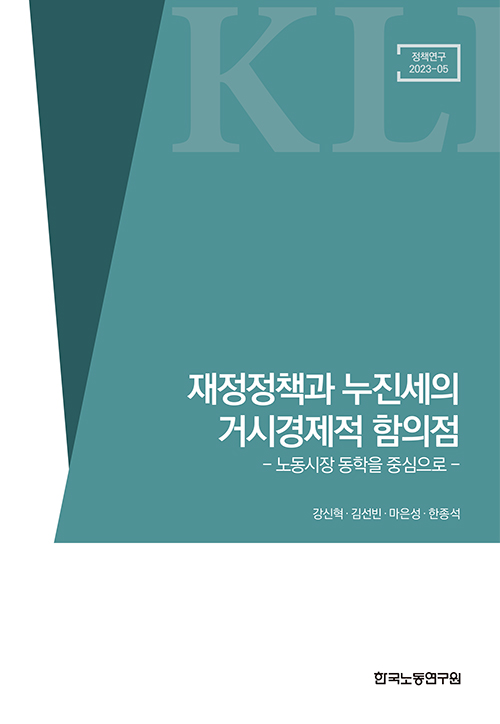한국노동연구원 'Research Series'에 대한 설명 입니다.
Research Series
Research Series

Macroeconomic Implications of Fiscal Policies and Progressive Taxes: Focused on the Dynamics of the Labor Market
- Author ShinHyuck Kang et al.
- Publication Date 2023.12.29
- Length 136
- ISBN 979-11-260-0666-3
Content
Chapter 1 Introduction
Chapter 2 A Model to Analyze an Optimal Progressive Tax System
Chapter 3 Analysis Results: An Optimal Progressive Tax System
Chapter 4 Analysis Results: An Optimal Progressive Tax System in an Aging Economy
Chapter 5 Boosting Consumption Effect of Transfer Payments according to Progressive Tax Level
Chapter 6 Analysis of Monetary and Fiscal Policy Effects Using a Directed Search Model
Chapter 7 Conclusion and Policy Implications
Summary
In this study, the impact of progressive taxes, which have a higher marginal tax rate for high-income earners, as well as monetary and fiscal policies such as transfer payments and unemployment benefits on the macroeconomy and individual economic agents was analyzed using structural models in various aspects. The progressive income tax system is a tax system with a clear trade-off between inequality and efficiency; and transfer payments have recently been not only mentioned often in the discourse on basic income but also widely discussed as a fiscal policy for income preservation in the era of low birth rate and population aging; and unemployment benefits are one of the most representative fiscal policies in the form of employment insurance.
This study contributed to academic and policy research by conducting the following analyses. First, an optimal progressive income tax system that maximizes social welfare in the current economy and in an economy where the demographic structure has changed due to low birth rates and an aging society was analyzed using the heterogeneous-agent overlapping-generations general equilibrium model with Learning-By-Doing (LBD). In addition to providing a methodology that can be applied to a variety of topics in a flexible manner, this study is the first attempt to analyze an optimal progressive tax system in the era of aging population beyond making long-term fiscal projection, making its contribution significant. Second, this study examined how transfer payments change the aggregate unit economy and distribution, such as consumption and labor supply, depending on the taxation method, presenting an analysis of quantitatively understanding the effect of temporary transfer payments such as disaster relief funds on consumption in the future. To this end, it calibrated the HADSGE (Heterogeneous Agent Dynamic Stochastic General Equilibrium) model, in which aggregate shocks that affect all economic agents in every season exist, and performed policy experiments and welfare analysis. In particular, by comparing the welfare levels of each group by scenario, it showed which economic agent will prefer which policy depending on policy changes, which is expected to serve as helpful basic data for policy makers. Third, this study examined how the progressivity of the income tax system and unemployment benefits affect the job search behavior of employed job seekers and unemployed job seekers. For this purpose, the study calibrated a directed search model in which heterogeneous households and representative companies exist and conducted a policy experiment. Although there is room for improvement in quantitative analysis in that interest rate changes due to policy changes are not reflected due to the assumption of a small-scale open economy, it has made a meaningful contribution in that it provided basic data to analyze the channels of policy effects spreading to heterogeneous workers and job seekers. (For the full text of the English summary, please download the “Download 2 English_Abstract”.)
 Source Indication + Commercial Use Prohibition + Change Prohibition
Source Indication + Commercial Use Prohibition + Change Prohibition